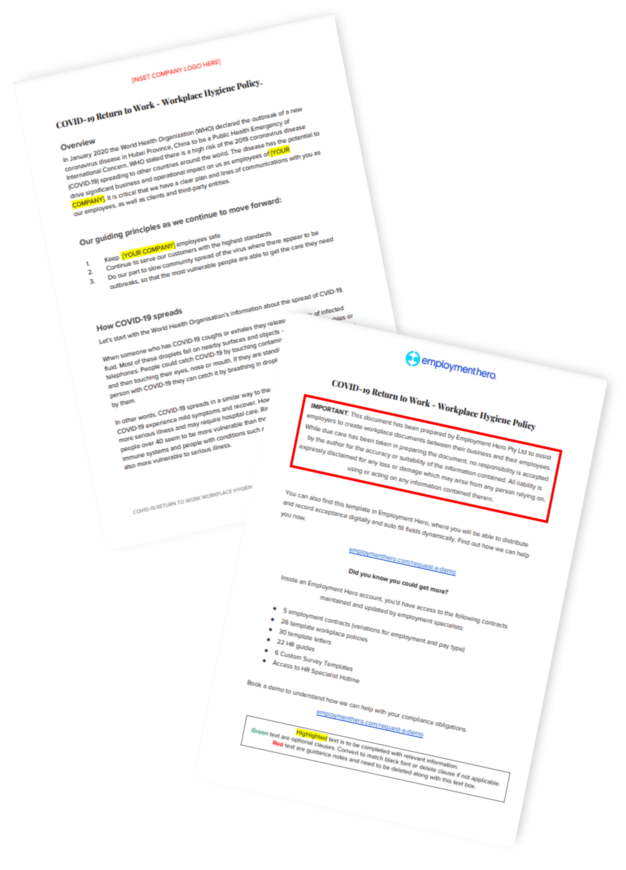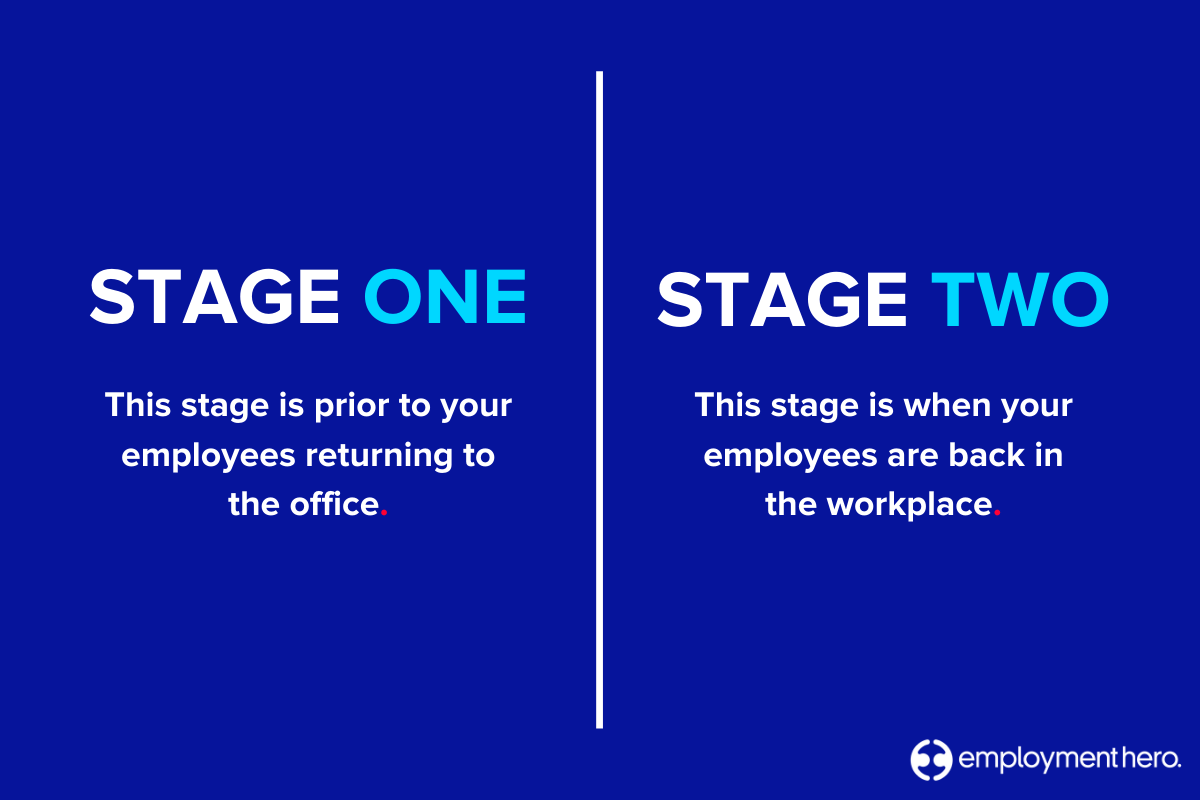
Planning a return to work for your employees? To ensure you’re doing all you can to help slow the spread and reduce the risk, you need to enact a new hygiene policy in your workplace.
This workplace hygiene policy is written and approved by Employment experts and is fully customisable to your business’s situation.
Download this free policy template now. Stay safe!

Workplace Health & Safety After COVID-19
As the world begins to gradually relax the restrictions that have been put in place over the last few months, it’s important you continue to keep your employees and your community safe. With COVID-19 updates occurring regularly across each country, we must work together to promote a COVID-safe workplace and comply with advice and regulations, such as workplace health and safety.
With this in mind, it’s important you acknowledge that your return to work will be different – this is not business as usual. This won’t be like coming back to the office after the Christmas break. It will involve strict hygiene policies, social distancing and a myriad of other measures to help keep your employees safe.
Disclaimer: Before we dive into the specifics of how to keep your team safe for their return, please note that the Australian federal government has introduced a 3 phase plan to ease restrictions. All COVID-19-related workplace health & safety measures are subject to change at the discretion of your state or territory government, and the advice in this article is general in nature.
As restrictions begin to ease, we have seen state and territory governments advising people to begin planning their return to work. This may seem like an overwhelming task to achieve, but broken up into more manageable phases and with the assistance and advice from SafeWork Australia, you’ll be on your way to ensuring your employees stay safe from day dot.
Ready to get back to work?
Read on as we share how you can manage the health and safety of your employees as they begin their return to work post-COVID-19.
Split your health and safety plan into two stages
To safely prepare for your team’s return to work, we suggest first developing a transition plan that involves two phases to break down the tasks involve
Stage one
This stage is prior to your employees returning to the office.
In this phase, the offices are not yet open but are preparing for a partial opening. All of the following workplace health and safety measures and procedures should be in place and communicated as needed before moving to Phase 2 of the COVID-19 transition plan. This is to ensure the office is safe for all team members.
Pro tip: Communicate, communicate, communicate! Your staff want to know exactly what is expected of them and in what timeframe.
Stage two
This stage is when your employees are back in the workplace.
It’s important to ensure that strict hygiene, social distancing and workplace screening policies are in place and followed upon your teams return to the office. This will ensure that you keep your employees safe and are prepared in the unfortunate event that you have to respond to a COVID-19 incident.
As per government advice, you can manage COVID-19 in your workplace and help stop the spread of the virus by implementing workforce screening, strict hygiene practices and physical distancing measures.
Introduce workforce screening
It is important to identify employees who are considered high-risk workers and ensure they comply with all COVID-19 health advice issued by the government to stay safe. Workers who are considered in the high-risk category include those who:
- Have known medical issues or a weakened immune system (e.g. chronic illness, cancer etc)
- Have recently returned from overseas
- Are older
- Have recently been in contact with a confirmed case of COVID-19
It’s also important to be aware that those who are considered vulnerable employees are at a greater risk of contracting the virus. You should assess the risks involved with vulnerable workers and organise alternate arrangements if possible, such as working from home or accommodating a workplace absence. These vulnerable individuals include those who are:
- People aged 65 years and older with a chronic medical condition
- Aboriginal and Torres Strait Islander people 50 years of age and older with a chronic medical condition
- People aged 70 years and over
- People with compromised immune systems
To help reduce the spread of COVID-19 and keep your employees safe, you can introduce multiple screening questions for employees as they enter the workplace, such as:
- Are you feeling unwell or experiencing any cold or flu-like symptoms?
- Do you have, or have you recently had a temperature?
- Have you been in contact with anyone who has been a confirmed case of COVID-19?
- Have you returned from overseas within the last 14 days?
If the employee answers yes to any of the above questions, the worker is unable to enter their usual place of work. You should direct them to seek medical advice immediately. This could involve the employee self-isolating for 14 days as per government advice before returning to their workplace. If you have an employee who answers yes to any of the above questions, seek advice from your state or territory health authority.
Enforce strict hygiene practices
COVID-19 is highly contagious and spreads easily through coughing and sneezing. It can also spread by coming in contact with contaminated surfaces, objects and hands. In your workplace, it’s crucial you introduce strict hygiene measures to keep your team safe. These measures should include:
- Providing hand sanitiser throughout your workplace. Place a bottle of hand sanitiser on each desk and in communal areas such as the kitchen, in the elevator, at all entrances and in meeting rooms
- Providing soap at all sinks
- Placing hygiene protocol posters around the office to remind employees that they must adhere to these measures to keep everyone safe
- Reminding employees to cough into their elbows or tissue and to place the tissue immediately into the rubbish bin
- Reduce the number of physical objects such as work-related documents your employees are touching. This could involve switching to digital files
- Introducing more regular and in-depth cleaning procedures across the office to ensure all surfaces, handles and lift buttons are fully sanitised at the end of each day
- Ensuring supplies of paper towels are topped up
- Enforcing best practices for entering and passing doorways (e.g. using the elbow to call for lifts, using body weight to push through doors where available)
Adhere to social distancing rules
As per Australian government advice, you will need to ensure your team adheres to the strict guidelines currently in place. As an employer, you are required to ensure that these are followed in the workplace and procedures are properly followed.
The current advice is:
1.5m between persons or 1 person per 4 square metres
 Some ways you can adhere to the social distancing rules include:
Some ways you can adhere to the social distancing rules include:
- Employees should eliminate contact with others, such as handshakes or embracing coworkers, etc
- Employees should avoid touching surfaces touched by others, to the extent feasible
- No events with external speakers or large gatherings should be planned until further notice in accordance with government advice
- No group lunches/catering/happy hours or other in-office group events should be planned until further notice
To adhere to this, employers should also implement arrangements to reduce the number of people in the workplace at any one time. Some ways you can reduce the number of people include:
- Splitting your teams into different cohorts and scheduling different days for them to come into the workplace
- Introduce staggered start and finish times for your team
- Put in place staggered meal and break times to reduce the number of people in communal spaces
- Reconsidering non-essential meetings
- Using video calls to replace in-person meetings
- Providing your team with the option to work from home if their role permits them to do so
- Introducing a hot desking setup with thorough cleaning at the end of each day
- Restrict workplace access to employees only for those who don’t need to interact with customers
Review your food and beverage safety measures
It’s important to review your food and beverage safety measures, especially if you offer your team perks including communal food, drinks or snacks throughout the day. Gone are the days of a 3 pm biscuit from the cookie jar, but now replaced with individually wrapped alternatives.
The last thing you want is a staff member coming into the office and spreading the virus through communal food.
To reduce your risk of cross-contamination, you should ensure:
- Snacks such as nuts, fruit and vegetables are individually packaged vs in bulk and not shared with anyone
- There should be no bread, pastries or cookies offered unless they’re individually packed
- No utensils should be reused by another person
- Gloves should be worn for any food or beverage handling for another individual
Follow the travel advice set out by your state or territory government
To help slow the spread, workers should travel in different vehicles if possible.
If they have to travel in the same vehicle, you can introduce measures to help keep them safe such as:
- Ensure workers are spread between the front and back seats if possible.
- Ensure there is hand sanitiser available in each vehicle.
- Emphasize that employees should only carry and come into contact with their own equipment, bags or toolkits.
- Introduce thorough and regular cleaning of the vehicle at the end of the shift or day. Door handles, seats, steering wheel, seatbelts and window controls should be the highest priority.
- Ensure employees maintain good personnel as per the guidelines above.
With travelling on public transport, you should adhere to the advice set out by your state or territory government. You could also introduce staggered working hours and allow those comfortable with working from home to continue to do so.
The wrap up
The return to work after a global pandemic isn’t your average return. It involves strict processes in place to ensure that your entire team stays safe.
By implementing safety measures such as workplace screening, strict hygiene practices, adhering to social distancing rules and adhering to travel advice from your state or territory government, we can all work together to slow the spread of COVID-19.
Want more?
If you’re looking for more information on managing your team’s return to work, we’ve put together these resources on everything you need to know to keep your team safe:
- How to support employees during COVID
- Effects of COVID-19 on mental health
- Vaccination survey report
- Return to work survey template
- Employee agreement to reduced salary
Download this template now.

